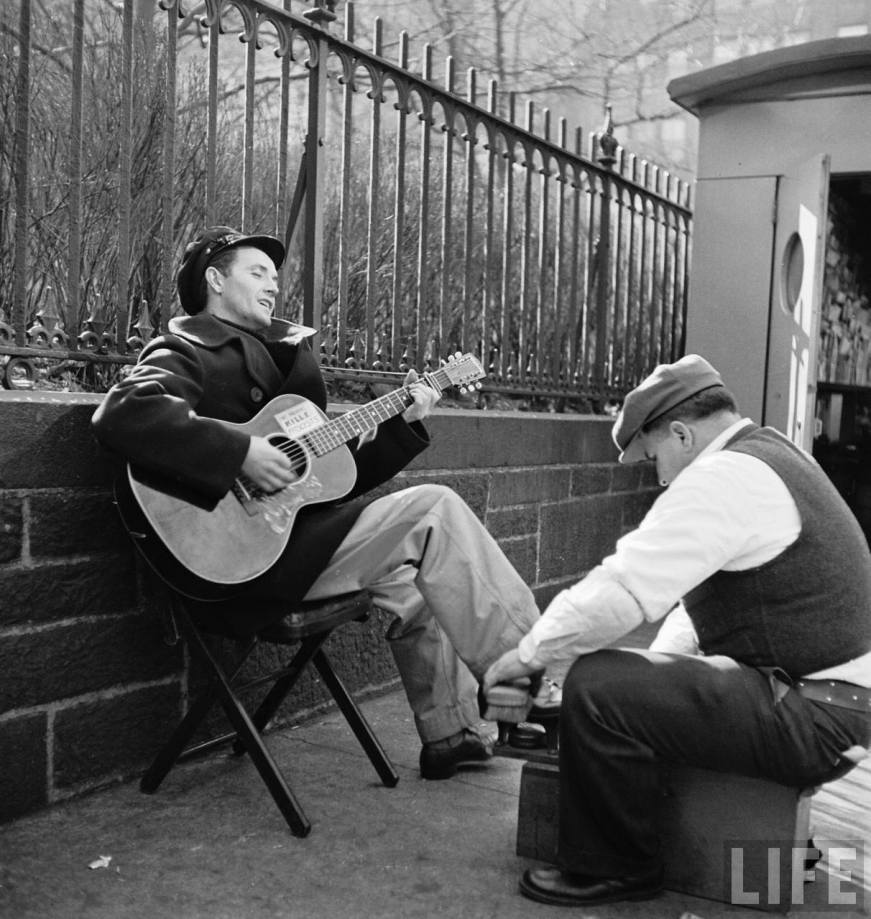Woody Guthrie gets a shoeshine in New York City, 1943. (Photo: LIFE Magazine)A Woody Guthrie Centennial Moment:
Woody Guthrie, Novelist
Lost 1947 manuscript offers ‘searing portrait of the Panhandle and its marginalized Great Depression residents’ and a timely message for today
The well-trumpeted Woody Guthrie news this month concerns the discovery and forthcoming publication of the only novel the folk singer ever wrote, House of Earth. Completed in 1947 but never released, the novel is being edited by actor Johnny Depp and historian Douglas Brinkley.
In an essay published in the July 9 edition of the New York Times Book Review, Depp and Brinkley say the book was influenced by Woody’s experiences in America’s Dust Bowl, as well as by John Steinbeck’s The Grapes of Wrath. Tracing the story of Tike and Ella May Hamlin, "hardscrabble farmers" in Texas, House of Earth is, they say, a "searing portrait of the Panhandle and its marginalized Great Depression residents.” Despite a slightly esoteric focus on the importance of adobe housing, House of Earth also includes graphic sex, including "a scorching lovemaking scene on a hay bale.” Brinkley says the approximately 250-page novel will be published in the spring of 2013.
At the time of its writing, Guthrie apparently shared House of Earth's first chapter with musicologist Alan Lomax, who called it "quite simply the best material I'd ever seen written about that section of the country.” But Guthrie showed the finished manuscript to only one person, filmmaker Irving Lerner, and it languished for decades in a Coney Island closet. After learning of its existence in the late ‘90s, Brinkley, with help from Guthrie’s daughter, Nora, finally tracked down the manuscript last year (at the McFarlin Library at the University of Tulsa) while researching a story on Bob Dylan for Rolling Stone. Brinkley brought Depp on board as co-editor. The two had previously worked together on Grammy-nominated liner notes for Gonzo, the soundtrack to a documentary about their mutual friend, Hunter S. Thompson, for whom Brinkley is literary executor.
Woody Guthrie, ‘This Land is Your Land’ (1944)Write Brinkley and Depp:
“House of Earth” was written as a direct response to the Dust Bowl. In December 1936 the rambling troubadour had an epiphany while busking for tips in New Mexico. He’d traveled there after a treacherous duster whacked the Texas Panhandle town of Pampa, where he’d been living in poverty. While in New Mexico, Guthrie became transfixed by an adobe hacienda’s sturdy rain spouts and soil-straw bricks, a simple yet solid weatherproof structure unlike most of his Texan friends’ homes, which were poorly constructed with flimsy wooden boards and cheap nails.
An immediate convert, Guthrie purchased a nickel pamphlet, “Adobe or Sun-Dried Brick for Farm Buildings,” from the United States Department of Agriculture. The manual instructed poor rural folk on building adobe homes from the cellar up. All an amateur needed was a home-brew of clay loam, straw and water. Guthrie promoted this U.S.D.A. guide with wild-eyed zeal. Adobes, he boasted, would endure the Dust Bowl better than wooden aboveground structures that were vulnerable to wind, snow, dust and termites. If sharecroppers and tenant farmers could only own a piece of land--even the uncultivable territory of arroyos and red rocks--they could build a “house of earth” that would protect them from dirt blowing in through cracks in the walls.
Woody Guthrie, ‘Talking Dustbowl Blues’ (1940)According to Brinkley and Depp, Guthrie put the manuscript away after 1947 and concentrated on songwriting, in part because his health was starting to deteriorate from complications of Huntingdon’s disease, but also perhaps sensing House of Earth “could be considered both passé (post-New Deal writing was frowned upon by cold-war-era critics) and ahead of its time (graphic sex). His fertility cycle prose was so edgy that publication was unlikely. And his use of an overdrawn hillbilly dialogue would have found little embrace in New York literary circles. Apparently, Guthrie never showed anyone other than the filmmaker Irving Lerner the remaining sections of the novel. (He hoped Lerner would use the book as the basis for a movie.)”
Claiming “Guthrie successfully mixes Steinbeck’s narrative verse with D.H. Lawrence’s openness to erotic exploration, Brinkley and Depp say that despite the novel’s “somewhat static narrative drive,” its “architectural intensity makes it a minor masterpiece.
Woody Guthrie, ‘Worried Man Blues’ (1944)“When we shared the finished novel with Bob Dylan,” they say, “he was blown away, ‘surprised by the genius,’ he said, of the prose. At heart, ‘House of Earth’ is a meditation about how poor people search for love and meaning in a corrupt world, one in which the rich have lost their moral compasses. Even though the backdrop is the washed-out agricultural fields of Texas, the novel could just as easily be set in a refugee camp in Sudan or a shantytown in Haiti.”
Indeed, say Brinkley and Depp, Woody’s novel anticipated the environmental crises to come: “Today, Texas is in the midst of a prolonged drought; global warming is a scientific fact; and wildfires, blizzards and tornadoes increasingly ravage the American landscape. The unerring rightness of adobe living is now more apparent than ever. It’s almost as if Guthrie had prophetically written ‘House of Earth’ with the summer of 2012 in mind.”
Founder/Publisher/Editor: David McGee
Contributing Editors: Billy Altman, Laura Fissinger, Christopher Hill, Derk Richardson
Logo Design: John Mendelsohn (www.johnmendelsohn.com)
Website Design: Kieran McGee (www.kieranmcgee.com)
Staff Photographers: Audrey Harrod (Louisville, KY; www.flickr.com/audreyharrod), Alicia Zappier (New York)
E-mail: thebluegrassspecial@gmail.com
Mailing Address: David McGee, 201 W. 85 St.—5B, New York, NY 10024




